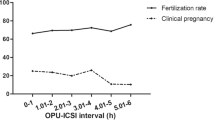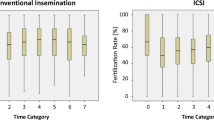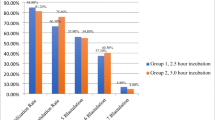Abstract
Purpose
To evaluate the association of time intervals between various steps of the intracytoplasmic sperm injection (ICSI) cycle with oocyte quality and reproductive outcomes.
Methods
We conducted a prospective study among patients undergoing ICSI cycles in an academic hospital between May 2017 and January 2019. The time intervals between the various steps of cycles were recorded. The ICSI cycles were categorized according to the different time intervals; human chorionic gonadotropin (hCG) injection to oocyte pick up (hCG-OPU) (≤ 36 h and > 36 h), OPU-denudation (≤ 2 h and > 2 h), and denudation-ICSI (≤ 2 h and > 2 h). The main outcome measures were oocyte dysmorphisms, fertilization, cleavage, biochemical, and clinical pregnancy rates.
Results
A total of 613 ICSI cycles using fresh autologous oocytes were included in this study. After adjusting for confounders, the hCG–OPU interval was associated with the presence of cytoplasmic granulation, inclusion body, and also the total number of morphologically abnormal premature oocytes in the cycle (P = 0.02, P = 0.04, P = 0.008, respectively). OPU-denudation interval was associated with cytoplasmic granulation and extended perivitelline space of the oocytes (P = 0.006 and P = 0.03, respectively). The denudation-ICSI interval was only associated with cytoplasmic granulation (P = 0.01). However, hCG–OPU, OPU–denudation, and denudation–ICSI intervals were not significantly associated with fertilization, cleavage, biochemical, and clinical pregnancy rates.
Conclusions
All the studied time intervals between various steps of ICSI procedure could affect oocyte quality, but the oocyte dysmorphisms were mainly associated with hCG-OPU interval. However, the time intervals were not associated with fertilization, cleavage, and pregnancy outcomes.
Similar content being viewed by others
Change history
29 May 2020
In the original article published, the values given in the variables are incorrect.
References
Yu EJ, Ahn H, Lee JM, Jee BC, Kim SH (2015) Fertilization and embryo quality of mature oocytes with specific morphological abnormalities. Clin Exp Reprod Med 42(4):156–162
Lazzaroni-Tealdi E, Barad DH, Albertini DF, Yu Y, Kushnir VA, Russell H, Wu Y-G, Gleicher N (2015) Oocyte scoring enhances embryo-scoring in predicting pregnancy chances with IVF where it counts most. PLoS ONE 10(12):e0143632
Eppig JJ (2001) Oocyte control of ovarian follicular development and function in mammals. Reproduction 122(6):829–838
Trapphoff T, Heiligentag M, Dankert D, Demond H, Deutsch D, Fröhlich T, Arnold G, Grümmer R, Horsthemke B, Eichenlaub-Ritter U (2015) Postovulatory aging affects dynamics of mRNA, expression and localization of maternal effect proteins, spindle integrity and pericentromeric proteins in mouse oocytes. Hum Reprod 31(1):133–149
Dozortsev D, Nagy P, Abdelmassih S, Oliveira F, Brasil A, Abdelmassih V, Diamond M, Abdelmassih R (2004) The optimal time for intracytoplasmic sperm injection in the human is from 37 to 41 hours after administration of human chorionic gonadotropin. Fertil Steril 82(6):1492–1496
Bárcena P, Rodríguez M, Obradors A, Vernaeve V, Vassena R (2016) Should we worry about the clock? Relationship between time to ICSI and reproductive outcomes in cycles with fresh and vitrified oocytes. Hum Reprod 31(6):1182–1191
Garor R, Shufaro Y, Kotler N, Shefer D, Krasilnikov N, Ben-Haroush A, Pinkas H, Fisch B, Sapir O (2015) Prolonging oocyte in vitro culture and handling time does not compensate for a shorter interval from human chorionic gonadotropin administration to oocyte pickup. Fertil Steril 103(1):72–75
Isiklar A, Mercan R, Balaban B, Alatas C, Aksoy S, Urman B (2004) Impact of oocyte pre-incubation time on fertilization, embryo quality and pregnancy rate after intracytoplasmic sperm injection. Reprod Biomed Online 8(6):682–686
Naji O, Moska N, Dajani Y, El-Shirif A, El-Ashkar H, Hosni MM, Khalil M, Khalaf Y, Bolton V, El-Toukhy T (2018) Early oocyte denudation does not compromise ICSI cycle outcome: a large retrospective cohort study. Reprod Biomed Online 37(1):18–24
Patrat C, Kaffel A, Delaroche L, Guibert J, Jouannet P, Epelboin S, De Ziegler D, Wolf J-P, Fauque P (2012) Optimal timing for oocyte denudation and intracytoplasmic sperm injection. Obstet Gynecol Int. https://doi.org/10.1155/2012/403531
Pereira N, Neri QV, Lekovich JP, Palermo GD, Rosenwaks Z (2016) The role of in-vivo and in-vitro maturation time on ooplasmic dysmaturity. Reprod Biomed Online 32(4):401–406
Pujol A, García D, Obradors A, Rodríguez A, Vassena R (2018) Is there a relation between the time to ICSI and the reproductive outcomes? Hum Reprod 33(5):797–806
Organization WH (2010) WHO laboratory manual for the examination and processing of human semen.
Balaban B, Urman B (2006) Effect of oocyte morphology on embryo development and implantation. Reprod Biomed Online 12(5):608–615
Mansour RT, Aboulghar MA, Serour GI (1994) Study of the optimum time for human chorionic gonadotropin—ovum pickup interval in in vitro fertilization. J Assist Reprod Genet 11(9):478–481
Mikkelsen AL, Lindenberg S (2001) Morphology of in-vitro matured oocytes: impact on fertility potential and embryo quality. Hum Reprod 16(8):1714–1718
Weiss A, Neril R, Geslevich J, Lavee M, Beck-Fruchter R, Golan J, Shalev E (2014) Lag time from ovulation trigger to oocyte aspiration and oocyte maturity in assisted reproductive technology cycles: a retrospective study. Fertil Steril 102(2):419–423
Bosdou JK, Kolibianakis EM, Venetis CA, Zepiridis L, Chatzimeletiou K, Makedos A, Triantafyllidis S, Masouridou S, Mitsoli A, Tarlatzis B (2015) Is the time interval between HCG administration and oocyte retrieval associated with oocyte retrieval rate? Reprod Biomed Online 31(5):625–632
Leoni GG, Naitana S (2018) Ovine Granulosa Cells Isolation and Culture to Improve Oocyte Quality. In: Epithelial Cell Culture. Springer, pp 95–106
Munakata Y, Kawahara-Miki R, Shiratsuki S, Tasaki H, Itami N, Shirasuna K, Kuwayama T, Iwata H (2016) Gene expression patterns in granulosa cells and oocytes at various stages of follicle development as well as in in vitro grown oocyte-and-granulosa cell complexes. J Reprod Dev. https://doi.org/10.1262/jrd.2016-022
Van de Velde H, De Vos A, Joris H, Nagy Z, Van Steirteghem A (1998) Effect of timing of oocyte denudation and micro-injection on survival, fertilization and embryo quality after intracytoplasmic sperm injection. Hum Reprod (Oxford, England) 13(11):3160–3164
Acknowledgements
This study is financially supported by Men's health and Reproductive Health Research Center (MHRHRC), Shahid Beheshti University of Medical Sciences, Tehran, Iran (grant number: 12102).
Author information
Authors and Affiliations
Contributions
EA: protocol development, data collection, data analysis, and manuscript writing; MN: data collection, data analysis, and manuscript writing; HN: project development and data collection; SS: project development and data collection; MK: data collection and data analysis; NB: data collection and data analysis; ZSM: project development, data analysis, and manuscript editing.
Corresponding author
Ethics declarations
Conflict of interest
The authors of the current paper declare no conflict of interest regarding all periods of working—neither financial support nor personal relationship. Elham Azizi declares that she has no conflict of interest. Mohammad Naji declares that he has no conflict of interest. Hamid Nazarian declares that he has no conflict of interest. Saghar Salehpour declares that she has no conflict of interest. Maryam Karimi declares that she has no conflict of interest. Nasrin Borumandnia declares that she has no conflict of interest. Zahra Shams Mofarahe declares that she has no conflict of interest.
Informed consent statement
Informed consent was obtained from all participants.
Additional information
Publisher's Note
Springer Nature remains neutral with regard to jurisdictional claims in published maps and institutional affiliations.
The original version of this article was revised due to the incorrect variable value given in the tables.
Rights and permissions
About this article
Cite this article
Azizi, E., Naji, M., Nazarian, H. et al. Does timing in ICSI cycle affect oocyte quality and reproductive outcomes? A prospective study. Arch Gynecol Obstet 302, 505–513 (2020). https://doi.org/10.1007/s00404-020-05555-w
Received:
Accepted:
Published:
Issue Date:
DOI: https://doi.org/10.1007/s00404-020-05555-w




